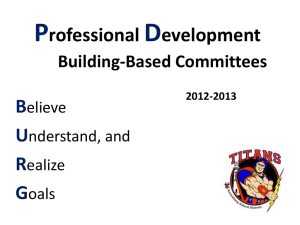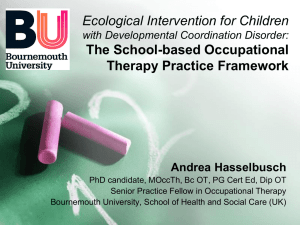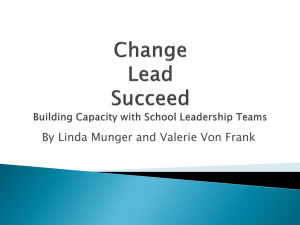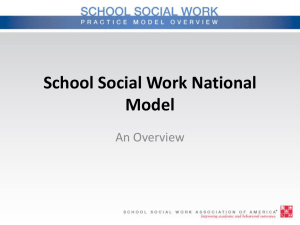PowerPoint - Student Support Services Project
advertisement
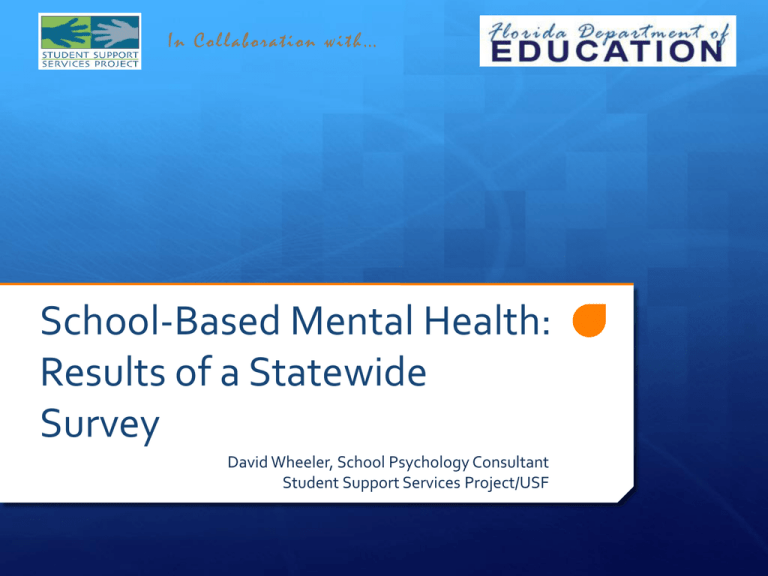
School-Based Mental Health: Results of a Statewide Survey David Wheeler, School Psychology Consultant Student Support Services Project/USF Gria Davison, School Social Work Consultant November 27, 1958 – September 14, 2013 Ana Grace Marquez-Greene A Parent’s Response Ana Grace Marquez-Greene Killed December 14, 2012 Sandy Hook Elementary School Best Practices for Creating Safe and Successful Schools - A Framework for Safe and Successful Schools, 2013 Integrate services through collaboration. Implement multi-tiered systems of support. Improve access to school-based mental health supports. Integrate school safety and crisis/emergency prevention, preparedness, response, and recovery. Balance physical and psychological safety. Employ effective, positive school discipline. Allow for the consideration of context. Acknowledge that sustainable and effective improvement takes patience and commitment. School-Based Mental Health Florida’s Framework for Promoting Social-Emotional and Behavioral Health What are school-based mental health services? Broad spectrum of assessment, prevention, intervention, postvention services. Essential to school’s ability to ensure a safe and healthy learning environment for all students, support students’ social-emotional needs, identify & respond to mental health problems, and promote students academic success. Ideally, school-based services dovetail with community- based services so that children and youth receive the support they need in a seamless, coordinated, and comprehensive system of care. Why school-based mental health? Mental health and psychological wellness are integral to school success. Students who receive social-emotional support and prevention services achieve better academically. Left unaddressed, mental health problems are linked to academic and behavior difficulties, dropping out, delinquency, and risk behaviors Growing and unmet need for mental health services for children and youth. Schools are a natural place to provide services. Wise investment – prevention and intervention are less costly than negative outcomes of unmet mental health problems. Adverse Childhood Experiences (ACE) Over 17,000 Kaiser Permanente members participated in a study to find out about how stressful or traumatic experiences during childhood affect adult health. • Emotional abuse • Physical abuse • Sexual abuse • Emotional Neglect • Physical Neglect • Domestic violence • Household substance abuse • Household mental illness • Parental separation/divorce • Incarcerated household member http://www.cdc.gov/ace/index.htm ACE Score correlated with Risk Alcoholism and alcohol Risk for intimate partner Chronic obstructive Multiple sexual partners abuse pulmonary disease (COPD) Depression violence Sexually transmitted diseases (STDs) Suicide attempts Unintended pregnancies Fetal death Early initiation of sexual Health-related quality of life activity Adolescent pregnancy Illicit drug use Smoking Liver disease Early initiation of smoking Prevalence of Mental Health Disorders in Children and Youth Approximately 20% of school-age children and youth have a diagnosable mental disorder (Merikangas et al., 2010; CDC, 2013); One in five children met criteria for psychiatric disorder at school entry (Carter et al., 2010) Most common mental health disorders (CDC, 2013) ADHD (7%) Behavior or conduct disorders (3.5%) Anxiety (3%) Depression (2%) 10% of Florida’s youth have mental health disorder causing significant functional impairment (Florida Adolescent Mental Health Fact Sheet) FL Youth Risk Behavior Survey (2011) Suicide/Depression 26% experienced significant feelings of sadness or hopelessness 21% seriously considered attempting suicide 7% attempted suicide at least once during the previous 12 months Suicide was the 2nd leading cause of death for 5-14 year olds, and the 3rd leading cause of death for 15-24 year olds in 2011 (Florida Vital Statistics Annual Reports) Bullying/Violence 14% were bullied on school property 10% engaged in a physical fight on school property 7% were threatened with a weapon on school property Total Bullying/Harassment Incidents (FL) Number of Incidents 8000 7000 6000 5000 4000 3000 2000 1000 0 2008-2009 2009-2010 2010-2011 Year 2011-2012 Who provides school-based mental health services? Student Services Personnel (school mental health professionals) School counselors – 5,433 (1:491) School psychologists – 1,381 (1:1940) School social workers – 1,008 (1:2658) School nurses – 1,163 (1:2286) Contracted mental health professionals Safe and Drug Free Schools Personnel School Resource Officers What are some challenges to SBMH? Systematic screening for mental issues is not a common practice. School-based mental health professionals are typically assigned to multiple schools and too often used for crisis response as opposed to crisis prevention. Limited access to professional development opportunities that address mental health issues. Fragmentation of services within schools and between school and community-based services. Multi-Tiered System of Supports & School-based Mental Health How are school-based mental health services provided? Few System of Supports for School-Based Mental Health Services Intensive, Individualized Interventions Brief individual counseling Individual Educational Plan w/ Counseling as a Related Service Behavior Intervention/Support Plan Crisis Intervention Targeted, Supplemental Interventions & Supports Small group interventions Anger management/self-management training Targeted social skills training Student Engagement/Attendance Peer counseling/peer mediation Adult mentor All Some Wraparound services Schoolwide, Preventive Systems of Support Schoolwide Positive Behavior Support Safe & Healthy Schools (School Climate) Schoolwide Social Skills Training Social/Emotional Learning Bullying Prevention Multi-tiered System of Support Tiered supports Tier 1 – Preventive services applied to all students Tier 2 – Targeted group interventions applied to some students Tier 3 – Intensive interventions applied to individual students Level of intervention support based on student need. Problem-solving and data-based decision making. Monitor the effectiveness of intervention/support. Intervention for Internalizing Disorders in a Three-tier Model UNIVERSAL TARGETED INTENSIVE All Students 15-20% of students about 5% of students - Effective classroom routines (PBS) - Effective policies and responses to bullying - School connectedness - Structured SEL curricula in general education - Targeted SEL programming - Individual treatment and case management - Special education - Small group counseling and skill training - Referral to community based services - Evidence-based group intervention programs - Wraparound services - Systems of Care Adapted from Merrell & Gueldner (2010). Preventive interventions for students with internalizing disorders. In Shinn & Walker (Eds.), Interventions for Achievement and Behavior Problems in a Three-Tier Model Including RTI. Mental Health in Schools Survey March 22 – April 5, 2013 Data was needed to determine: 1. What part a multitiered system of supports plays in implementing Mental Health services (prevention; intervention; response) in public schools. 2. If school-based Mental Health services are provided within a positive student engagement framework. 3. What existing services are provided to public school students (K12) who have mental health needs or other behavioral issues. 4. What role student services personnel play in collaboration among schools, law enforcement, mental health agencies, and other local organizations. 5. If students with mental health needs are receiving mental health services and/or treatment. Response to Survey 47 Districts (70% of districts in FL) 78 Respondents Respondent role in district Director/Coordinator/Supervisor of Student Services ESE Directors Supervisor/Coordinator of Student Service Profession List mental health prevention services provided in your district. Multi-tiered supports (schoolwide/universal supports) Positive Behavior Support (e.g., PBS, CHAMPS, Tough Kids) Developmental guidance program Bullying, Suicide, and Substance Abuse Prevention programs (e.g., Silence Hurts Initiative, Be Safe, HOPE curriculum, Kids at Hope) Character education programs Social skills training (e.g., Skillstreaming, Stop and Think, Too Good for Violence Early Warning Systems School climate initiatives Health education Who provides the training for prevention services? District and school Student Services personnel Community Mental Health Agencies & Outside Mental Health Providers (e.g., DCF, Children’s Services Council) FDOE funded Projects – FLPBS, FDLRS, ISRD District PBS staff and behavior analysts SEDNET County Health Department Professional Associations Webinars University Who receives the training for prevention services? Student services staff School staff (administrators, teachers, support staff) District employees Students Parents Who provides the training for intervention services? Student Services staff District staff (Safe & Healthy Schools, PBS, Health Services) Community Mental Health agencies & outside professionals FDLRS, ISRD, PAEC, DCF Who receives the training for intervention services? Student services staff District staff & administrators School staff Contracted mental health providers Educators & Parents Who provides the training for response services? Student Services staff ESE & Student Services staff District staff Community mental health and emergency response partners Outside agencies Specialized training (NOVA) Who receives the training for response services? Crisis response team Student Services staff District staff School administrators School staff/teachers ESE specialists What other trainings are being implemented? Crisis Intervention Training (PREPaRE, NOVA) Bullying and Suicide Prevention Awareness and Training (e.g., Gate Keeper Training, Eight to Great, Early Warning Signs, Silence Hurts) American Red Cross Psychological First Aid Positive Behavior Supports Critical Incident Stress Management Risk Assessment/Threat Assessment Training Briefly explain their involvement in Baker Act Student services staff collaborate with police (SROs) to Baker Act – help determine if criteria are met. Initiate the process – refer to SRO after completing risk/threat assessment. Assess and Baker when needed (primarily LCSW but other qualified licensed staff, too). Provide follow-up (school psychologist, social worker, counselor). Make referral to law enforcement (SRO). Part of response/crisis team that provides crisis intervention and determine when Baker Act is necessary. Communication and support to family. Implications of Survey Need for systematic screening to identify students needing social- emotional support. Target Prevention for improvement in district activities/tools/systems. Ensure that existing MH providers are appropriately used to address prevention, intervention, crisis response needs. Rather than mandated PD or programs in isolation, establish a holistic approach that incorporates the critical and common elements across issues. Need for greater collaboration and coordination between school and community mental health resources. Mutual Aid Agreement among districts would be a logical recommendation. Next Steps? Mental Health Screening Systematic Mental Health Screening: Annually assess school climate. Build capacity of school staff to recognize when social- emotional and behavioral barriers to learning are present. Screen for mental health and behavioral issues at the school level: Assess overall level of risk present in school Identify students needing intervention Provide support for identified students. School Screening – Pros/Cons Schools provide ready access MH is one of those matters and reduce costs. that should remain a domain for family, not school, intervention. Schools are a direct beneficiary because screening and effective treatment enhances student success at school. Scarce school time/resources will be used for matters not directly related to teaching. There are not enough competent school personnel to plan, implement, and evaluate large-scale screening. UCLA Center for School Mental Health – Policy Brief 52 Screening issues/dilemmas Community Acceptance Family Rights Identification – False positives Treatment Chafouleas et al., (2010). Ethical Dilemmas in School-Based Behavioral Screening. 53 Consent for screening? SBE Rule 6A-6.0331 problem solving activities that include the provision of educational and behavioral evaluations, services, and supports. The Protection of Pupil Rights Amendment (PPRA) requires written parental consent for participation in surveys or evaluations that reveal sensitive personal information including mental and psychological problems http://www2.ed.gov/policy/gen/guid/fpco/ How do we reconcile? Use existing student data Use indirect & prosocial screening methods Include parents in the problem solving process Remember the purpose of screening – do not need a diagnosis 54 Systematic Screening Methods Early Warning Systems Gated Screening Methods Systematic Screening for Behavior Disorders (SSBD) – Walker & Severson Adaptive Model of Behavioral Assessment (AMBA) – Volpe Screening Scales Student Risk Screening Scale (SRSS) – Drummond Student Internalizing Behavior Screener (SIBS) – Cook Teen Screen – National Center for Mental Health Checkups Prosocial Behavior/Positive Psychology scales RtI:B Database Early Warning Systems Indicators Thresholds Attendance Student missed 10% of more of instructional time (absences) Course Performance Failure in one or more courses Earned 2.0 or lower GPA (4-point scale) Behavior Locally validated thresholds (e.g., referrals, inor out-of-school suspensions, behavior grades) http://betterhighschools.org/ Student Internalizing Behavior Screener 58 RtI:B Database rtidb@usf.edu www.flrtib.org 59 Student Support Services Project Promoting School-based Mental Health Policies & Practices Promoting School-based Mental Health Policies & Practices Policy Recommendations to Legislature Collaborative Partnership between Student Support Services, Safe Schools, & Emergency Management Development of a Comprehensive Student Services Plan Establish Professional Practices (SSPEM) Resources for School-based Mental Health Websites Student Support Services http://sss.usf.edu FL Multi-tiered System of Supports www.florida-rti.org/ SSPEM & School-Based Mental Health Collaborates with teachers and administrators to develop and implement school-wide positive behavior supports. Collaborates with school personnel and students to foster student engagement (e.g., involvement, motivation, persistence, resilience, ownership). Promotes safe school environments. Provides a continuum of crisis intervention services. Provides relevant information regarding child and adolescent development, barriers to learning, and student risk factors. Recommendations for House Healthy Families Committee Require districts develop and implement a Comprehensive Student Services Plan that supports student mental health within a multi-tiered, prevention/intervention framework. Annually assess school climate and require universal screening for mental health and behavioral issues at the school level. Build capacity school staff to promote healthy development and recognize social-emotional/behavioral barriers to learning. Provide school-wide programs to promote social-emotional development and enhance resiliency and protective factors. Promote a continuum of services that includes school-wide mental health prevention programming and intensive interventions. Recommendations for House Healthy Families Committee Use student Services personnel (school social workers, school psychologists, and school counselors) to provide school-based mental health interventions. Expand school-based mental health services to focus on early identification and use of evidence-based interventions for social-emotional issues. Support professional development and access to relevant trainings for Student Services personnel. Enhance System of Care approach for coordination and continuity of mental health services among schools, agencies, and community providers, especially for youth involved in multiple agencies. School-Based Mental Health Resources Evidence-based Interventions National Registry of Evidence-Based Programs (SAMHSA) http://nrepp.samhsa.gov/ Evidence-based resilience-enhancing and violence prevention programs http://www.samhsa.gov/grants/content/2002/YouthViolence/evide nce_based.htm Suicide Prevention Resource Center – Best Practices Registry http://www.sprc.org/bpr Promising Practices Network http://www.promisingpractices.net/ Summary of Recognized Evidence-based Programs http://csmh.umaryland.edu/Resources/ClinicianTools/index.html What Works Clearinghouse http://ies.ed.gov/ncee/wwc/ Student Support Services Heather Diamond hdiamond@usf.edu Curtis Jenkins ctjenkins@usf.edu Helen Lancashire hlancash@usf.edu Dianne Mennitt dmennitt@usf.edu David Wheeler wheeler@usf.edu Jayna Jenkins jayna@usf.edu http://sss.usf.edu/
